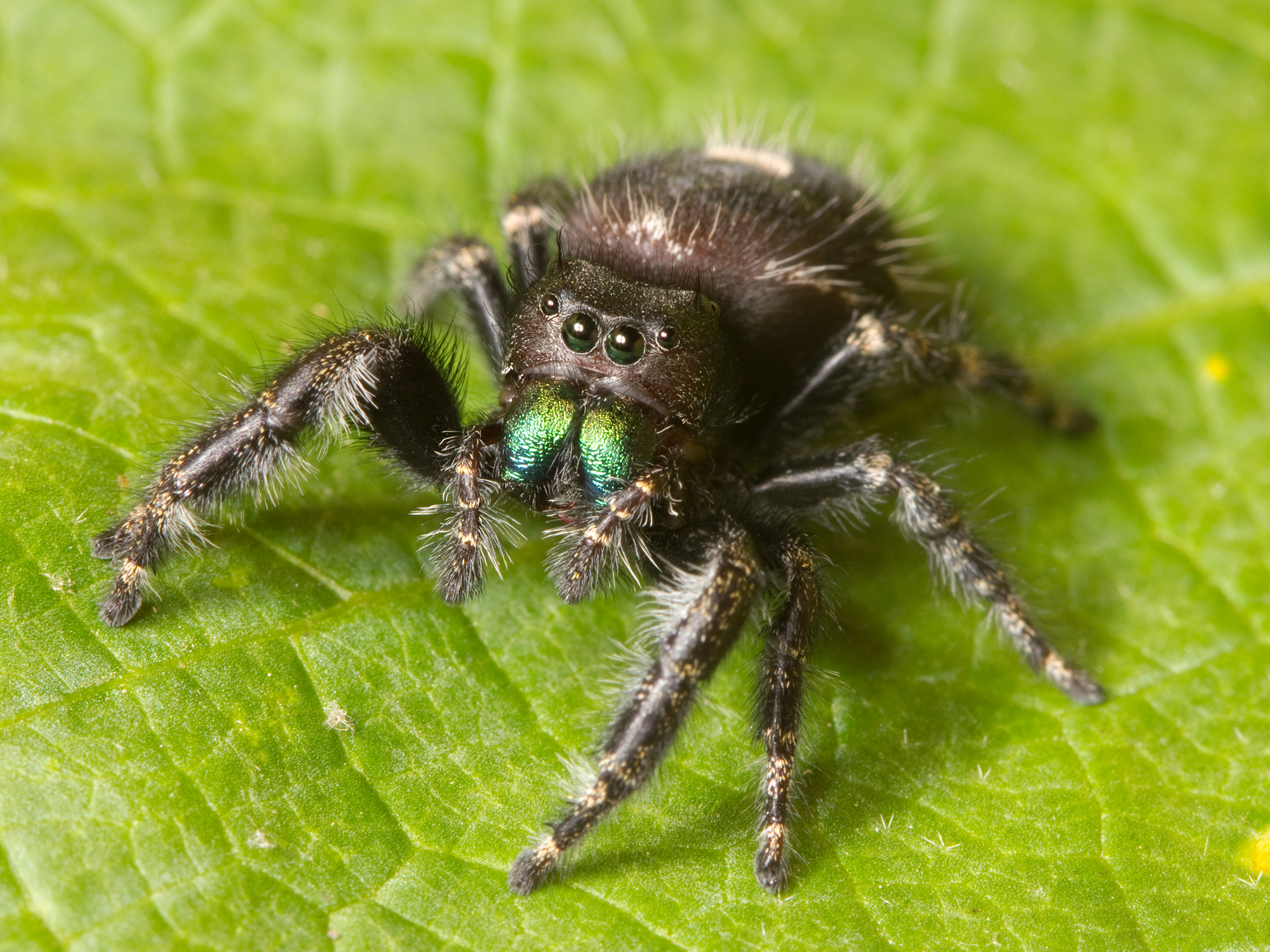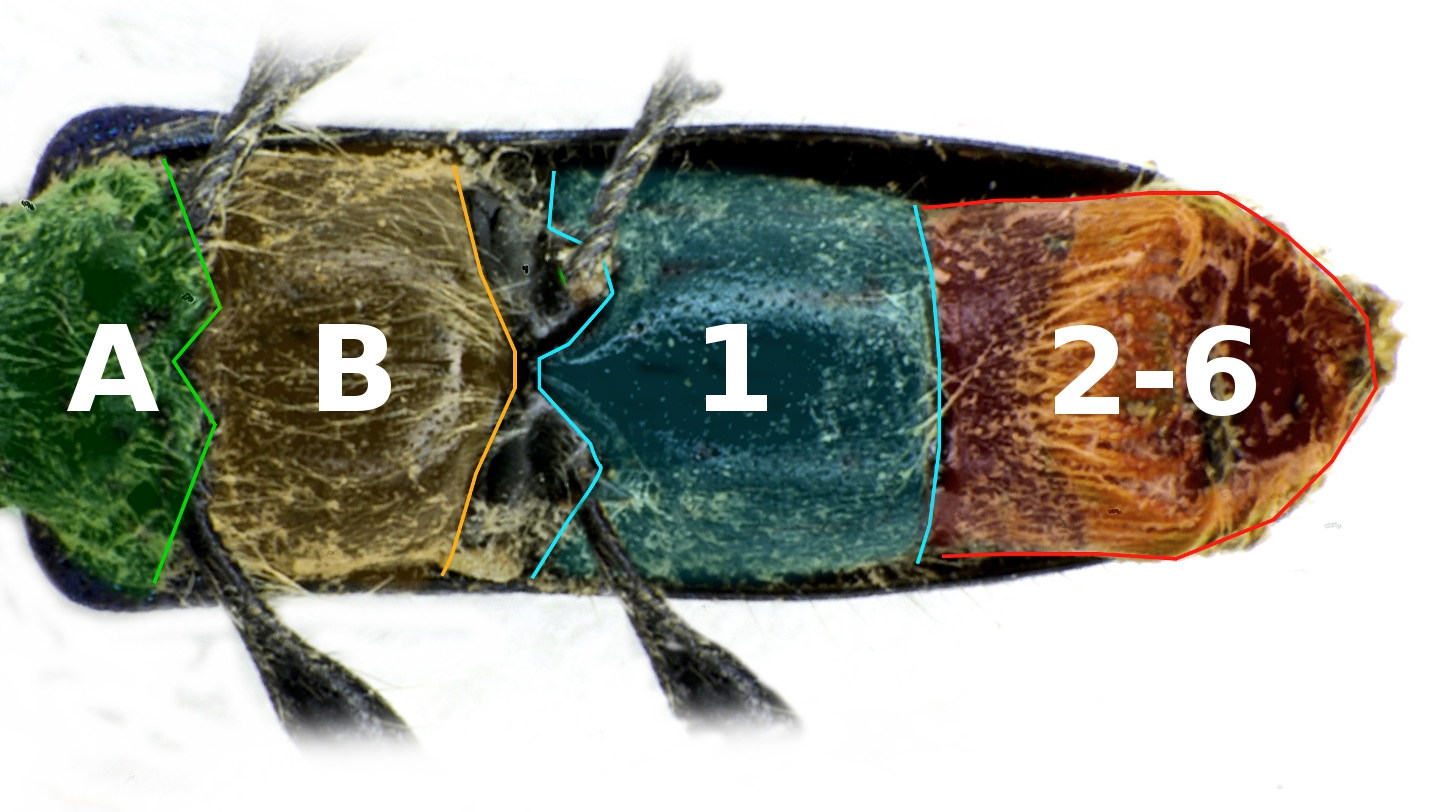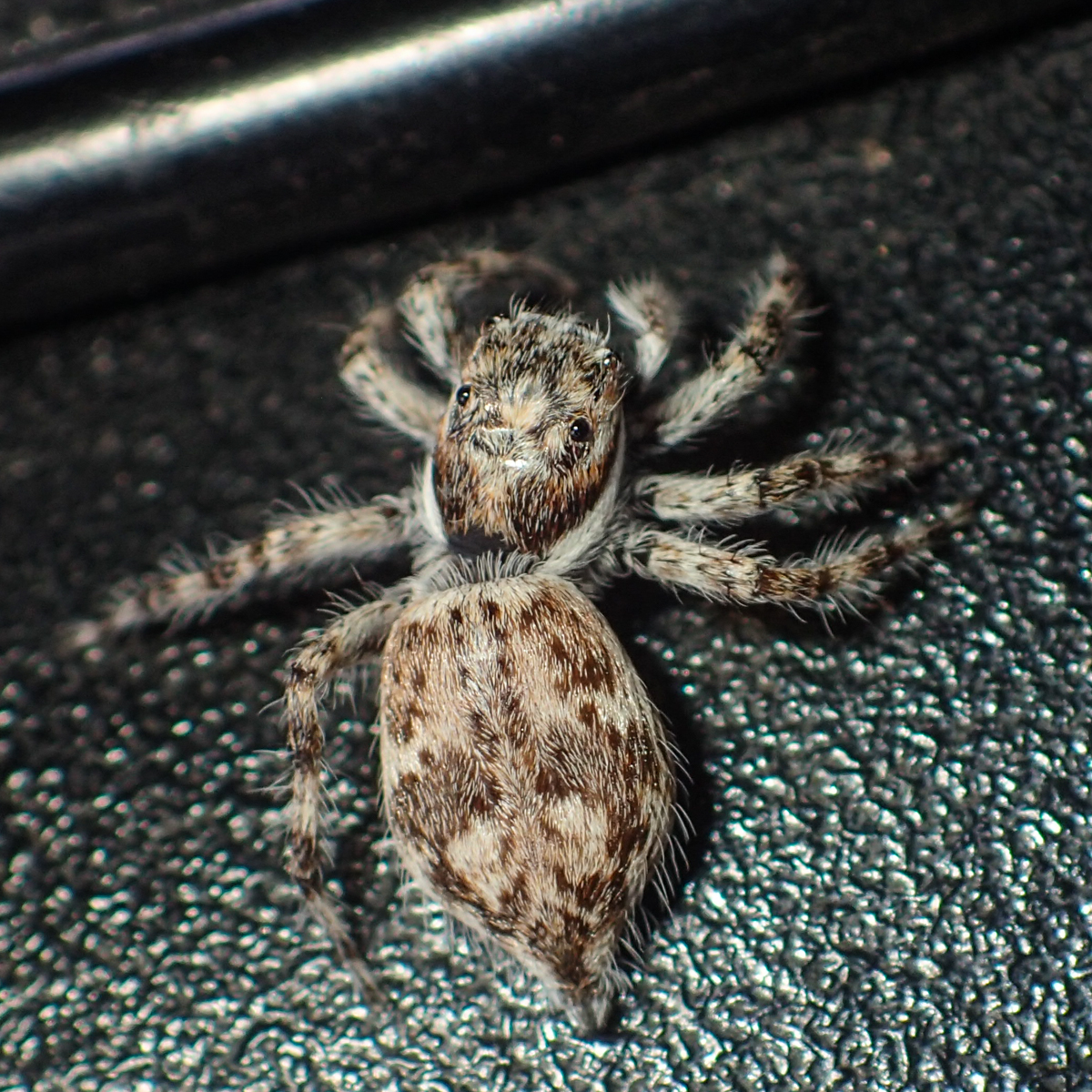|
Stenaelurillus Hirsutus
''Stenaelurillus hirsutus'' is a species of jumping spider in the genus '' Stenaelurillus'' that lives in Central Africa, Congo, Ghana, Kenya, Senegal, Tanzania, and Uganda. The species name is the Latin word for hairy and the genus name is related to the Greek words for narrow and cat. It lives in a wide range of environments, including hot dry places and amongst stones near rivers. The spider is small, with a cephalothorax that ranges in length between in length and an abdomen between long. The male is distinguished by its black and white striped pattern on the anterior of the carapace and the existence of a mane of light-coloured hairs around the eye field that is reminiscent of a Mohawk hairstyle. The female's epigyne has a deep narrow pocket and bean-shaped copulatory openings. The male's clypeus has a distinctive pattern of three vertical white stripes on its otherwise black exterior. The species was first described in 1927 by Robert de Lessert. Taxonomy ''Stenaeluri ... [...More Info...] [...Related Items...] OR: [Wikipedia] [Google] [Baidu] |
Species
A species () is often defined as the largest group of organisms in which any two individuals of the appropriate sexes or mating types can produce fertile offspring, typically by sexual reproduction. It is the basic unit of Taxonomy (biology), classification and a taxonomic rank of an organism, as well as a unit of biodiversity. Other ways of defining species include their karyotype, DNA sequence, morphology (biology), morphology, behaviour, or ecological niche. In addition, palaeontologists use the concept of the chronospecies since fossil reproduction cannot be examined. The most recent rigorous estimate for the total number of species of eukaryotes is between 8 and 8.7 million. About 14% of these had been described by 2011. All species (except viruses) are given a binomial nomenclature, two-part name, a "binomen". The first part of a binomen is the name of a genus to which the species belongs. The second part is called the specific name (zoology), specific name or the specific ... [...More Info...] [...Related Items...] OR: [Wikipedia] [Google] [Baidu] |
Circumscription (taxonomy)
In biological taxonomy, circumscription is the content of a taxon, that is, the delimitation of which subordinate taxa are parts of that taxon. For example, if we determine that species X, Y, and Z belong in genus A, and species T, U, V, and W belong in genus B, those are our circumscriptions of those two genera. Another systematist might determine that T, U, V, W, X, Y, and Z all belong in genus A. Agreement on circumscriptions is not governed by the Codes of Zoological or Botanical Nomenclature, and must be reached by scientific consensus. A goal of biological taxonomy is to achieve a stable circumscription for every taxon. This goal conflicts, at times, with the goal of achieving a natural classification that reflects the evolutionary history of divergence of groups of organisms. Balancing these two goals is a work in progress, and the circumscriptions of many taxa that had been regarded as stable for decades are in upheaval in the light of rapid developments in molecu ... [...More Info...] [...Related Items...] OR: [Wikipedia] [Google] [Baidu] |
Labium (arthropod Mouthpart)
The mouthparts of arthropods have evolution, evolved into a number of forms, each adaptation, adapted to a different style or mode of feeding. Most mouthparts represent modified, paired appendages, which in ancestral forms would have appeared more like legs than mouthparts. In general, arthropods have mouthparts for cutting, chewing, piercing, sucking, shredding, siphoning, and filtering. This article outlines the basic elements of four arthropod groups: insects, myriapods, crustaceans and chelicerates. Insects are used as the model, with the novel mouthparts of the other groups introduced in turn. Insects are not, however, the Arthropod#Classification of arthropods, ancestral form of the other arthropods discussed here. Insects Insect mouthparts exhibit a range of forms. The earliest insects had chewing mouthparts. Specialisation includes mouthparts modified for siphoning, piercing, sucking and sponging. These modifications have evolved a number of times. For example, m ... [...More Info...] [...Related Items...] OR: [Wikipedia] [Google] [Baidu] |
Chelicerae
The chelicerae () are the arthropod mouthparts, mouthparts of the subphylum Chelicerata, an arthropod group that includes arachnids, horseshoe crabs, and sea spiders. Commonly referred to as "jaws", chelicerae may be shaped as either articulated fangs, or as a type of pincer_(biology), pincers. Some chelicerae, such as those found on nearly all spiders, are hollow and contain (or are connected to) venom glands, used to inject venom into prey or a perceived threat. Both pseudoscorpions and Opiliones , harvestmen have additional structures on their chelicerae that are used for grooming (papillae in pseudoscorpions, cheliceral teeth in Opiliones). In ''Paratrechalea'', males and females have shown to have a chelicerae dimorphism, because the chelicerae is used as a mating signal for females. Types Chelicerae can be divided into three kinds: jackknife chelicerae, scissor chelicerae, and three-segmented wikt:chelate, chelate chelicerae. Jackknife chelicerae The jackknife chelicer ... [...More Info...] [...Related Items...] OR: [Wikipedia] [Google] [Baidu] |
Sternum (arthropod Anatomy)
The sternum (: sterna) is the ventral portion of a segment of an arthropod thorax or abdomen. In insects, the sterna are usually single, large sclerites, and external. However, they can sometimes be divided in two or more, in which case the subunits are called sternites, and may also be modified on the terminal abdominal segments so as to form part of the functional genitalia, in which case they are frequently reduced in size and development, and may become internalized and/or membranous. For a detailed explanation of the terminology, see Kinorhynchs have tergal and sternal plates too, though seemingly not homologous with those of arthropods.Sørensen, M. V. et al. Phylogeny of Kinorhyncha based on morphology and two molecular loci. PLoS One 10, 1–33 (2015). Ventrites are externally visible sternites. Usually the first sternite is covered up, so that ventrite numbers do not correspond to sternite numbers. The term is also used in other arthropod groups such as crustaceans, ... [...More Info...] [...Related Items...] OR: [Wikipedia] [Google] [Baidu] |
Punk Fashion
Punk fashion is the clothing, hairstyles, cosmetics, jewellery, and body modifications of the punk counterculture. Punk fashion varies widely, ranging from Vivienne Westwood designs to styles modeled on bands like The Exploited to the dressed-down look of North American hardcore. The distinct social dress of other subcultures and art movements, including glam rock, skinheads, Greaser (subculture), greasers, and Mod (subculture), mods have influenced punk fashion. Punk fashion has likewise influenced the styles of these groups, as well as those of popular culture. Many punks use clothing as a way of making a statement. The early, pre-fame work of designer Vivienne Westwood helped pioneer the look of early British punk with her scene-establishing clothing shops Sex (boutique), Sex and Sex (boutique)#Seditionaries, Seditionaries in the mid-1970s, co-run with Malcolm McLaren who managed the Sex Pistols. Westwood was asked by then-partner McLaren to outfit the Sex Pistols, and Westwood ... [...More Info...] [...Related Items...] OR: [Wikipedia] [Google] [Baidu] |
Thorax
The thorax (: thoraces or thoraxes) or chest is a part of the anatomy of mammals and other tetrapod animals located between the neck and the abdomen. In insects, crustaceans, and the extinct trilobites, the thorax is one of the three main divisions of the body, each in turn composed of multiple segments. The human thorax includes the thoracic cavity and the thoracic wall. It contains organs including the heart, lungs, and thymus gland, as well as muscles and various other internal structures. The chest may be affected by many diseases, of which the most common symptom is chest pain. Etymology The word thorax comes from the Greek θώραξ ''thṓrax'' " breastplate, cuirass, corslet" via . Humans Structure In humans and other hominids, the thorax is the chest region of the body between the neck and the abdomen, along with its internal organs and other contents. It is mostly protected and supported by the rib cage, spine, and shoulder girdle. Contents The ... [...More Info...] [...Related Items...] OR: [Wikipedia] [Google] [Baidu] |
Wanda Wesołowska
Wanda Wesołowska (born 11 August 1950) is a Polish zoologist known for her work with jumping spiders. She has described more species of jumping spider than any contemporary writer, and is second only to Eugène Simon in the history of arachnology. Originally a student of ornithology, she developed an interest in jumping spiders while still a student at the Siedlce University of Natural Sciences and Humanities in the 1970s. Wesołowska published her first work in 1981, which included the description of nine new species of spiders, the first in what would be a prolific career. She moved to the University of Wrocław to continue her studies, and completed her doctoral thesis that described 44 new species of the genus ''Heliophanus''. She joined the faculty of the University of Wrocław in 1985, received a habilitation in 2000, and remained a Academic tenure, tenured professor at the university until her retirement in 2020. Her research has focused on the description, taxonomy and ... [...More Info...] [...Related Items...] OR: [Wikipedia] [Google] [Baidu] |
Jerzy Prószyński
Jerzy Prószyński (born 1935 in Warsaw) is a Polish arachnologist specializing in systematics of jumping spiders (family Salticidae). He is a graduate of the University of Warsaw, a long-term employee of the Siedlce University of Natural Sciences and Humanities and the Institute of Zoology of the Polish Academy of Sciences in Warsaw. Biography In 1957 he completed his biological studies at the University of Warsaw. During his studies he was employed at the Institute of Zoology of the Polish Academy of Sciences in Warsaw, where he conducted research on spiders in the Kampinos Forest. Between 1963 and 1967 he lectured on zoology at the University of Ghana. In 1966 he obtained his Ph.D. at the Adam Mickiewicz University in Poznań. A year later he was given the opportunity to pursue a postdoctoral fellowship at Harvard University Harvard University is a Private university, private Ivy League research university in Cambridge, Massachusetts, United States. Founded ... [...More Info...] [...Related Items...] OR: [Wikipedia] [Google] [Baidu] |
Clade (biology)
In biology, a clade (), also known as a monophyletic group or natural group, is a group of organisms that is composed of a common ancestor and all of its descendants. Clades are the fundamental unit of cladistics, a modern approach to taxonomy adopted by most biological fields. The common ancestor may be an individual, a population, or a species (extinct or extant). Clades are nested, one in another, as each branch in turn splits into smaller branches. These splits reflect evolutionary history as populations diverged and evolved independently. Clades are termed ''monophyletic'' (Greek: "one clan") groups. Over the last few decades, the cladistic approach has revolutionized biological classification and revealed surprising evolutionary relationships among organisms. Increasingly, taxonomists try to avoid naming taxa that are not clades; that is, taxa that are not monophyletic. Some of the relationships between organisms that the molecular biology arm of cladistics has revealed i ... [...More Info...] [...Related Items...] OR: [Wikipedia] [Google] [Baidu] |
Wayne Maddison
Wayne Paul Maddison (born 1958) is a Canadian evolutionary biologist, arachnologist, and biological illustrator. He is Canada Research Chair in Biodiversity and a professor at the departments of zoology and botany at the University of British Columbia, and the Director of the Spencer Entomological Collection at the Beaty Biodiversity Museum. Education and career Maddison was born in London, Ontario and his interests in studying spiders started while he was a teenager exploring Lake Ontario. Maddison studied zoology at the University of Toronto, where he obtained his BSc in 1980. He went on to study at Harvard University in the Department of Organismic and Evolutionary Biology, where he obtained his PhD in 1988 under the supervision of Herbert W. Levi. He was a NSERC postdoctoral fellow at the University of California, Berkeley from 1988 to 1990, where he worked with Montgomery Slatkin. Maddison became an assistant professor and later associate professor at the University o ... [...More Info...] [...Related Items...] OR: [Wikipedia] [Google] [Baidu] |
Tribe (biology)
In biology, a tribe is a taxonomic rank above genus, but below family and subfamily. It is sometimes subdivided into subtribes. By convention, all taxa ranked above species are capitalized, including both tribe and subtribe. In zoology, the standard ending for the name of a zoological tribe is "-ini". Examples include the tribes Caprini (goat-antelopes), Hominini (hominins), Bombini (bumblebees), and Thunnini (tunas). The tribe Hominini is divided into subtribes by some scientists; subtribe Hominina then comprises "humans". The standard ending for the name of a zoological subtribe is "-ina". In botany, the standard ending for the name of a botanical tribe is "-eae". Examples include the tribes Acalypheae and Hyacintheae. The tribe Hyacintheae is divided into subtribes, including the subtribe Massoniinae. The standard ending for the name of a botanical subtribe is "-inae". In bacteriology, the form of tribe names is as in botany, e.g., Pseudomonadeae, based on the ge ... [...More Info...] [...Related Items...] OR: [Wikipedia] [Google] [Baidu] |





